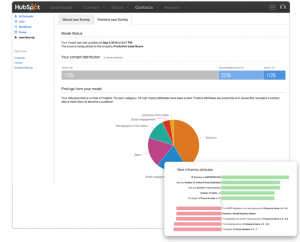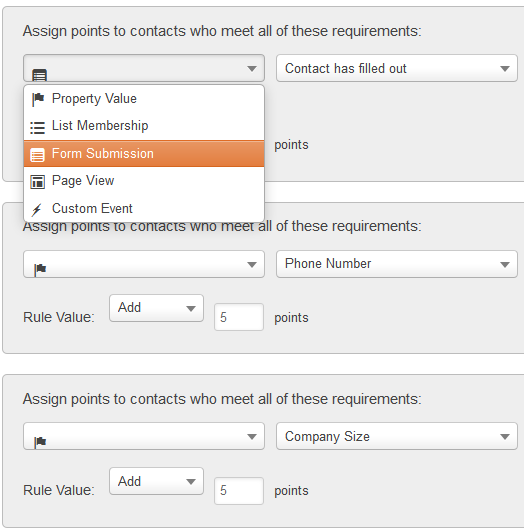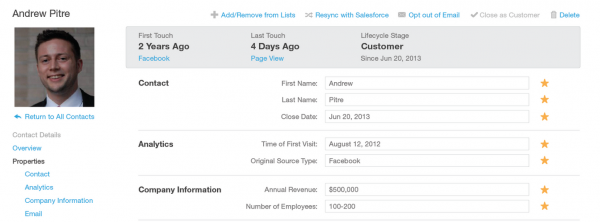
 Lead scoring involves separating high-quality leads that are almost ready to buy from leads that either aren’t yet ready to make a purchasing decision or will never become customers.
Lead scoring involves separating high-quality leads that are almost ready to buy from leads that either aren’t yet ready to make a purchasing decision or will never become customers.
Only the high-quality leads are sent to sales, ensuring that the sales team only invests their limited time and resources in prospects that are more likely to become customers. In this way, organizations can increase conversion rates and deliver a more efficient and successful sales process.
A powerful feature of marketing automation, lead scoring works by automatically attaching a value to each lead based on their personal information, professional data, behaviors, and interactions with your content. For example, a decision maker viewing your products and pricing page will be scored higher than an administrative employee viewing the very same pages. Each time the lead completes a new action on your site – such as viewing new content, requesting additional information, or downloading a free demo – their score changes to determine whether or not they are ready to speak to sales.
Nurtured leads produce, on average, a 20% increase in sales opportunities versus non-nurtured leads. -- See, Sales Enablement Statistics

Sales nurturing and lead nurturing processes simply create efficiency and increase the number of sales opportunities for companies. See also: What is inbound sales?
Here are the four key steps of lead scoring:
1. Identify what characteristics qualified leads possess.
The first step of lead scoring is to figure out what type of lead is most likely to become a customer based on the data you currently have. To do this, you’ll need to work with the sales team to identify the characteristics your customers generally share. For example, do they have a certain job title? What is their industry, company size, and company type? Are they decision-makers in their organization? Where are they located? Once you know these key characteristics, ask for that data on your lead generation forms when a prospect downloads a piece of content or signs up for your newsletter.

2. Identify what behaviors qualified leads display.
Next, you’ll want to evaluate the close rates of your website’s conversion events to determine how qualified leads typically behave. The goal is to identify which conversion events close the most sales, and what activities led to those conversions. Consider activities like requesting a free trial, downloading an e-book or webinar, and viewing product pages.
For example, you may find that requesting a free trial and pricing information means the lead is 80% more likely to become a buyer when compared to leads who only view your free blog content. Also, look at how active the lead was on your website before they made their purchasing decision. How many pieces of content did they view and how many forms did they complete? How long does it take for a typical lead to become a customer, and how much time must pass before you can safely assume that the lead will never make a purchase? All of this information will help you separate high-quality, truly valuable leads from everyone else.
3. Assign values to each behavior and characteristic.
Create a points system from 0 to 100 and assign values to each lead behavior and characteristic. For example, let’s say your ideal lead is a high-level decision maker at a company with 1,000 to 2,000 employees. In addition, based on your lead intelligence data, you know that most qualified leads request a free demo, view your pricing pages and visit at least ten web pages before becoming a customer. Once you have that information, you can begin assigning scores to various characteristics and behaviors.
For example, a lead who works at a large company with 1,500 employees may get 20 points, while an employee who works at a smaller organization with 20 employees may only get one point. In addition, a president or VP at a qualified company may earn 20 points, while a lower level employee may earn negative points because they aren’t qualified to make a purchasing decision.
4. Separate your leads accordingly.
Once your points system is created, it’s time to identify what numerical value means the lead is ready to be engaged by the sales team. For example, a vice president at a large company in a relevant industry who has consumed ten pieces of content and viewed your pricing pages will receive a very high score, indicating that they are ready to speak to sales.
Conversely, that same employee who has been less active on your site, but has downloaded several pieces of premium content, would be sent to your lead nurturing program. From there, the marketing and lead generation team can send the lead continuous digital communications based on their interests. In this way, the lead is nurtured until they indicate that they are ready to make a purchasing decision by completing high-level actions like viewing your pricing pages, requesting a free demo, and interacting with your content more frequently.
by Jonathan Franchell, CEO of Ironpaper - For more tips and hacks: Need to remove a new line after h1 tags? Both web designers and SEO practitioners need to employ headline tags: H1, H2, H3 in several ways to improve web page structure and tag...

The Crowded Arena of the IT Marketplace Updated December 2024 The Information Technology (IT) landscape is experiencing rapid growth and intensifying competition. IT spending is projected to reach nearly 5.1 trillion U.S. dollars in 2024, a...

The marketing industry is transforming significantly due to generative AI and increasing market complexity. Gartner's prediction of a 25% decline in traditional search traffic suggests that the era of search engines is dying. AI tools, particularly...

Updated December, 2024 The field of digital marketing is evolving rapidly in response to new technology and changing buyer expectations. To help career-minded marketers, we’ve rounded up the top 10 skills needed to succeed in the field. These are...
